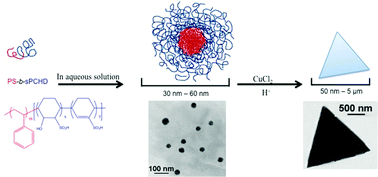Building triangular nanoprisms from the bottom-up: a polyelectrolyte micellar approach
Abstract
Charge-regulated synthesis of triangular prisms in aqueous solution using self-assembled polyelectrolyte micelles as templates is described in detail. Micelles formed from amphiphilic polystyrene-block-sulfonated poly(1,3-cyclohexadiene) (PS-b-sPCHD) serve as templates to direct the formation of novel triangular prisms of CuCl2 single crystals. We demonstrate that the edge lengths of these triangular prisms can be easily tailored at room temperature from the nanoscale to the mesoscale by simply adjusting the ratio of charged micelles to

- This article is part of the themed collection: 2013 Journal of Materials Chemistry B Hot Papers

 Please wait while we load your content...
Please wait while we load your content...